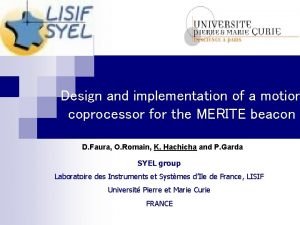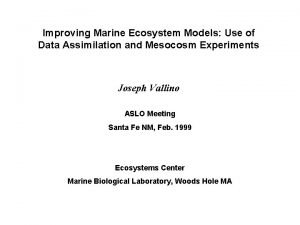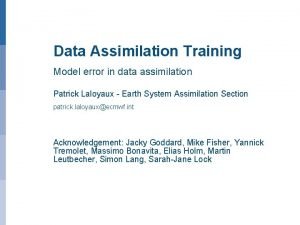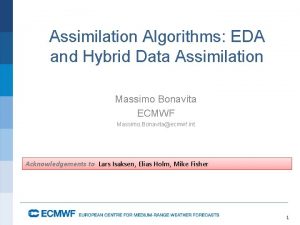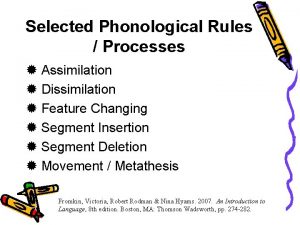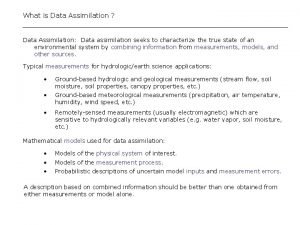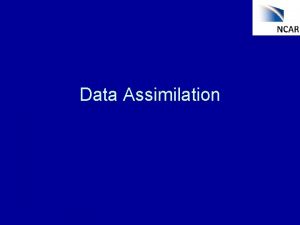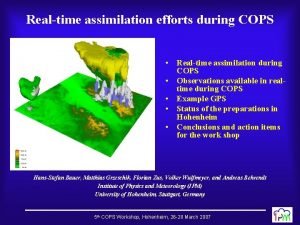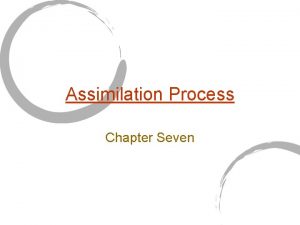Evaluating Coprocessor Effectiveness for the Data Assimilation Research




















- Slides: 20

Evaluating Coprocessor Effectiveness for the Data Assimilation Research Testbed Ye Feng IMAGe DARe. S SIPar. CS University of Wyoming

Introduction • Task: evaluating the feasibility and effectiveness of coprocessor on DART. • Target: get_close_obs ( profiling result: computationally intensive & executed multiple times during a typical DART run. ) • Coprocessor: NVDIA GPUs with CUDA Fortran. • Result: Parallel version of exhaustive search on GPU is faster.

Problem Obs(3) Obs(16) Obs(15) Obs(2) Obs(4) Obs(14) Base obs Obs(13) Obs(5) Obs(9) Obs(12) Obs(8) Obs(6) Obs(11) Obs(10) Calculate: the horizontal distances between base location and observation locations. Obs(7)

Obs(3) Obs(16) Obs(15) Obs(2) Obs(4) Obs(14) Base obs Obs(13) Obs(5) maxdist Obs(9) Obs(12) Obs(8) Obs(6) Obs(11) Obs(10) Find: the close observations. Obs(7)

cclose_ind cdist 1 d 1 2 d 2 5 d 5 8 d 8 9 d 9 11 d 11 12 d 12 13 d 13 EASY! or is it?

It is easy on CPU Data Dependency But GPU doesn’t work this way! Problems with data dependency usually don’t scale so well on GPU. • cnum_close depends on previous cnum_close value. • cclose_ind and cdist both depend on cnum_close.

GPU Scan: Take the 1 st bit of dist d 1 diff 1 psum 1 d 2 1 2 d 3 0 2 d 4 - maxdist = 0 Prefix Sum 2 3 d 5 1 d 6 0 3 d 7 0 3 d 8 1 4 Most Significant Bit (1 st bit) cnum_close 1, dist<maxdist (close) 0, dist>maxdist (not close)

GPU Scan: psum 1 Diff_sum d 1 diff 1 d 2 1 2 2 0 d 3 0 0 2 0 0 d 4 0 0 2 0 1 d 5 1 3 3 0 d 6 0 0 3 0 0 d 7 0 0 3 0 1 d 8 1 4 4 diff 1 dist d 1 cdist 1 1

Extract: Thread ID Diff_sum cdist cclose_ind cdist 1 d 1 2 d 2 1 1 d 1 2 2 d 2 3 0 0 5 d 5 4 0 0 8 d 8 5 3 d 5 6 0 0 7 0 0 8 4 d 8 What we want What we have How can we independently eliminate the zeros and extract the indices

Solution? diff Thread ID Diff_sum 1 1 2 2 0 3 0 0 4 0 1 5 3 0 6 0 0 7 0 1 8 4 If diff. not. 0 Then cclose_ind=Thread ID cclose_ind 1 2 If diff = 0 Then throw it away 5 8

diff Thread ID Diff_sum 1 1 2 2 0 3 0 0 4 0 1 5 3 0 6 0 0 7 0 1 8 4 If diff. not. 0 Then cclose_ind=Thread ID cclose_ind 1 2 If diff = 0 NO Then throw it away Branching! 5 8

Solution! Thread ID Diff_sum cdist cclose_ind cdist 1 1 d 1 2 2 d 2 3 0 0 3 0 5 0 d 5 4 0 0 4 0 8 0 d 8 5 3 d 5 5 6 0 0 7 0 0 8 4 d 8 8 cnum_close

Device Functions: • gpu_dist • gpu_scan si: number of iterations performed in this kernel. si=2 8 threads/block 16 element/block dist array: • extract Block 1 Block 2 sn: number of gpu_scan blocks that each extract block in this kernel handles. Result from gpu_scan: sn=4

CPU-GPU(si-sn) Execution Time 250 235, 2918 225 200 175 cpu time GPU 1 --1 125 GPU 1 --2 GPU 1 --4 100 GPU 1 --8 GPU 1 --16 75 GPU 1 --32 50 36, 24907 25 23, 53562 2* 10 24 *1 02 4 4 24 *1 02 10 02 4 *1 51 2 02 4 *1 *1 12 8 25 6 02 4 24 10 64 * 24 10 32 * 24 10 16 * 10 24 8* 10 24 4* 10 24 0 2* Time (ms) 150 Data Size GPU 1 --64

GPU(si=1, sn=1) Speedup 9 8 7, 81 7, 24 7, 23 7, 19 7 6, 49 6, 48 5 4, 87 4 GPU 1 --1 3, 32 3 2, 29 2 1, 49 1, 13 1 2* 10 24 *1 02 4 4 24 *1 02 10 02 4 *1 51 2 02 4 *1 *1 12 8 25 6 02 4 24 10 64 * 24 10 32 * 24 10 16 * 10 24 8* 24 10 4* 10 24 0 2* Speedup 6 Data Size

GPU(si-sn) Speedup 12 10, 55 11 10 9 8 GPU 1 --1 GPU 1 --2 6 GPU 1 --4 5 GPU 1 --8 GPU 1 --16 4 GPU 1 --32 3 GPU 1 --64 2 1 2* 10 24 *1 02 4 4 24 *1 02 10 02 4 *1 51 2 02 4 *1 *1 12 8 25 6 02 4 24 10 64 * 24 10 32 * 24 10 16 * 10 24 8* 10 24 4* 10 24 0 2* Speedup 7 Data Size

GPU(si-sn) Speedup 12 10, 96 11 10 9 7 GPU 2 --1 6 GPU 2 --2 GPU 2 --4 5 GPU 2 --8 4 GPU 2 --16 GPU 2 --32 3 GPU 2 --64 2 1 2* 10 24 *1 02 4 4 24 *1 02 10 02 4 *1 51 2 02 4 *1 *1 12 8 25 6 02 4 24 10 64 * 24 10 32 * 24 10 16 * 10 24 8* 10 24 4* 10 24 0 2* Speedup 8 Data Size

GPU(si-sn) Speedup 12 10, 95 11 10 9 8 GPU 4 --1 GPU 4 --2 6 GPU 4 --4 5 GPU 4 --8 GPU 4 --16 4 GPU 4 --32 3 GPU 4 --64 2 1 2* 10 24 *1 02 4 4 24 *1 02 10 02 4 *1 51 2 02 4 *1 *1 12 8 25 6 02 4 24 10 64 * 24 10 32 * 24 10 16 * 10 24 8* 10 24 4* 10 24 0 2* Speedup 7 Data Size

Conclusion • CUDA Fortran on GPU gave significant speedup vs CPU (10 x+). • Step outside the box (redesign the algorithm). • In order to get good performance, si and sn need to be tuned. • Be careful with using device memory. • There’s still room to improve the performance of this project.

Acknowledgements DARe. S/IMAGe Helen Kershaw (Mentor) Nancy Collins (Mentor) Jeff Anderson Tim Hoar Kevin Raeder UCAR NCAR Richard Loft Raghu Raj Prasanna Kumar Kristin Mooney Silvia Gentile Carolyn Mueller University of Wyoming
 Motion coprocessor
Motion coprocessor Jedi data assimilation
Jedi data assimilation Data assimilation
Data assimilation Data assimilation tutorial
Data assimilation tutorial Data assimilation
Data assimilation Data assimilation
Data assimilation Data assimilation
Data assimilation Data assimilation
Data assimilation Data assimilation
Data assimilation Reporting and evaluating research
Reporting and evaluating research Reporting and evaluating research
Reporting and evaluating research What are the criteria for evaluating secondary data
What are the criteria for evaluating secondary data Criteria for evaluating secondary data
Criteria for evaluating secondary data Cognition ap psych definition
Cognition ap psych definition Elision examples phonetics
Elision examples phonetics Regressive assimilation examples
Regressive assimilation examples Assimilation of voice examples
Assimilation of voice examples Examples of carbohydrase
Examples of carbohydrase Example of assimilation in child development
Example of assimilation in child development Dissimilation definition
Dissimilation definition Preoperational stage
Preoperational stage
